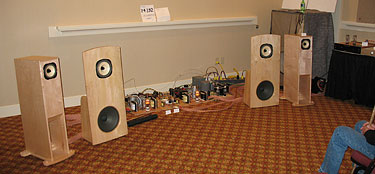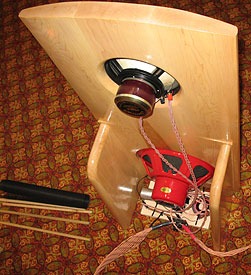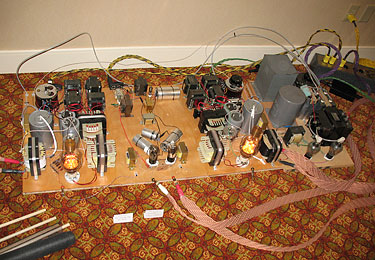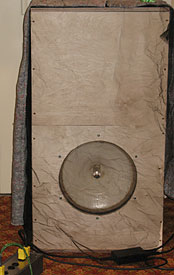OB woofer for tube amps
I’m looking for an open baffle woofer for use with NFB tube amps with low damping factors. Since Martin uses solid state amps, his published simulations and actual builds do not reflect the results that can be expected when the speakers are driven by tube amps. So, I doubt the Alpha 15 would be a good driver choice. With Martin’s worksheets no longer available, I am somewhat in the dark concerning a good choice. Maybe the Beta 15 would work. Any actual experiences?
I’m looking for an open baffle woofer for use with NFB tube amps with low damping factors. Since Martin uses solid state amps, his published simulations and actual builds do not reflect the results that can be expected when the speakers are driven by tube amps. So, I doubt the Alpha 15 would be a good driver choice. With Martin’s worksheets no longer available, I am somewhat in the dark concerning a good choice. Maybe the Beta 15 would work. Any actual experiences?
Hi,
I am using Beta 15 on a narrowish OB. I have not been so happy with its bass until I tried Graham's T-bass circuit:
http://www.diyaudio.com/forums/showthread.php?s=&threadid=130679
and my speakers:
http://www.diyaudio.com/forums/showthread.php?s=&threadid=110452&perpage=25&pagenumber=6
On the downside, T-bass circuit needs a SS amp capable of driving very low impedance loads.
If you decide to go with Betas, then you better biamp, driving Betas via SS amp and T-bass, and a fullrange of your choice via tube amp.
Overall, I have the impression that there are many more people happy with Alphas on OB than Betas...
Good Luck,
Vix
I am using Beta 15 on a narrowish OB. I have not been so happy with its bass until I tried Graham's T-bass circuit:
http://www.diyaudio.com/forums/showthread.php?s=&threadid=130679
and my speakers:
http://www.diyaudio.com/forums/showthread.php?s=&threadid=110452&perpage=25&pagenumber=6
On the downside, T-bass circuit needs a SS amp capable of driving very low impedance loads.
If you decide to go with Betas, then you better biamp, driving Betas via SS amp and T-bass, and a fullrange of your choice via tube amp.
Overall, I have the impression that there are many more people happy with Alphas on OB than Betas...
Good Luck,
Vix
Random newbie thoughts:
Martin has said (a few times) that there is no essential difference between tube and solid state -- tube is equivalent to SS + series resistance of some value, and thus tube is just less flexible because the value cannot be reduced (because it's built in).
Now he chose the Alpha's in part because of the high Q, which counters (or mates nicely with) the rolloff due to the baffle width. So if you are going to have more series resistance, which raises the Q, doesn't that just mean you merely have to compensate?
You could compensate in a few ways, e.g. less baffle, less boundary compensation, or "lose" the bass in whatever other way. What's your room like?
Martin has said (a few times) that there is no essential difference between tube and solid state -- tube is equivalent to SS + series resistance of some value, and thus tube is just less flexible because the value cannot be reduced (because it's built in).
Now he chose the Alpha's in part because of the high Q, which counters (or mates nicely with) the rolloff due to the baffle width. So if you are going to have more series resistance, which raises the Q, doesn't that just mean you merely have to compensate?
You could compensate in a few ways, e.g. less baffle, less boundary compensation, or "lose" the bass in whatever other way. What's your room like?
rjbond3rd said:Now he chose the Alpha's in part because of the high Q, which counters (or mates nicely with) the rolloff due to the baffle width. So if you are going to have more series resistance, which raises the Q, doesn't that just mean you merely have to compensate?
You could compensate in a few ways, e.g. less baffle, less boundary compensation, or "lose" the bass in whatever other way.
Absolutely correct. The key to doing OB design is to trade-off the type of amp, the power required and resulting SPL/W/m, the effective driver Qts (including any series resistance), the baffle size and shape, and the crossover location and slope. This requires some engineering of the system to get the bass to work out right and to transition smoothly to the next driver up in the frequency range. Unfortunately the state of the art design method for OB speakers, as seen on the various DIY forums, seems to be a cut and try technique throwing different drivers, crossovers, baffles, and external filters together to try and get optimum bass without any up front engineering. That is not the way I do the OB design work but to each his own.
Bob Brines said:Why would you want to drive the(sub)woofer with tubes?
Bob
So in light of what Martin and Robert describe as methods available to resolve the issue of adjusting for the amp's damping factor in the total system design formula, the answer could be that the original poster likes the sound of the particular tube amps he has in mind - that is, enough to try it for himself.
No doubt there are many tubed amplifiers that fall flat on their faces when measured on the bench at their power/ bandwidth limits, but there could just as well be some that wouldn't in this particular application.
If I can interpret Bob's response a little bit. This is based on my experiences.
If you plan on using a full range driver, hence the question in this forum, for most of the frequency range it will probably come with an efficiency in the mid 90 dB/W/m. In that case you really need a OB bass design that can produce a mid 100 dB/W/m output. This means multiple very efficient woofers or an active woofer system with significant power for the bass drivers ...... hence a plate or SS amp.
A passive OB system that is also efficient and is consistent with a low watt tube amp would require some thought with respect to the bass driver(s) selection and the crossover. A SS or plate amp and active crossover makes a lot of sense combined with the lower watt tube amp driving only the full range driver, this combination is a much easier and more flexible design.
If you plan on using a full range driver, hence the question in this forum, for most of the frequency range it will probably come with an efficiency in the mid 90 dB/W/m. In that case you really need a OB bass design that can produce a mid 100 dB/W/m output. This means multiple very efficient woofers or an active woofer system with significant power for the bass drivers ...... hence a plate or SS amp.
A passive OB system that is also efficient and is consistent with a low watt tube amp would require some thought with respect to the bass driver(s) selection and the crossover. A SS or plate amp and active crossover makes a lot of sense combined with the lower watt tube amp driving only the full range driver, this combination is a much easier and more flexible design.
Lowther America at VSAC 2008 - not a small room and neither was the sound, but this is certainly a bit of a hair-shirt shock hazard method to do OB & Bass

OB panels (Lowther PM6A - Tone Tubby Alnico Guitar speaker @ 200Hz)

most fun tho was the amps

to be honest - I don't know about the XO and amp for the Hartley Sub

OK, clearly not a low budget DIY project, but it clearly indicates that if you can afford to throw financial and in this case safety considerations to the wind ....

OB panels (Lowther PM6A - Tone Tubby Alnico Guitar speaker @ 200Hz)

most fun tho was the amps

to be honest - I don't know about the XO and amp for the Hartley Sub

OK, clearly not a low budget DIY project, but it clearly indicates that if you can afford to throw financial and in this case safety considerations to the wind ....
OK, what I am suggesting is that while anything is possible, why do things the hard way. SS is great for bass, tubes are great for the top end. It makes life much more simple to do it that way. There is really nothing to gain by using tube for bass other than proving that it can be done.
Bob
Bob
I agree that using an active crossover with a solid state woofer amp on the low pass side has many attractions and I certainly would go that route for a subwoofer.
As a first OB speaker project I was considering something similar to MJK’s passive two-way speaker, but driven by tube amps because those are what I build and enjoy and they are the best amps in my house (IMHO). My thinking was that the Beta 15 would be significantly underdamped with a no feedback tube amp and might work as well as the Alpha 15 with a feedback (high damping factor) amp. I understand how to calculate the effect of added series resistance on Qts, but in the absence of simulation tools such as MJK’s worksheets I was seeking guidance from actual experience. It seems Nelson is the only poster who has actually tried this driver in OB. For simulation, I suppose I can use Edge together with the driver’s infinite baffle response (adjusted for series resistance) to approximate the OB response.
If I were to actively crossover, I would prefer not to mix solid state and tube power amps for crossovers in the midrange (300 – 400 Hz). Of course, I might like it if I tried it, and I do have some unbuilt gainclone kits sitting on my shelf.
BTW, I attended VSAC 2008 and I thought the sound in the Lowther of America room was quite good.
As a first OB speaker project I was considering something similar to MJK’s passive two-way speaker, but driven by tube amps because those are what I build and enjoy and they are the best amps in my house (IMHO). My thinking was that the Beta 15 would be significantly underdamped with a no feedback tube amp and might work as well as the Alpha 15 with a feedback (high damping factor) amp. I understand how to calculate the effect of added series resistance on Qts, but in the absence of simulation tools such as MJK’s worksheets I was seeking guidance from actual experience. It seems Nelson is the only poster who has actually tried this driver in OB. For simulation, I suppose I can use Edge together with the driver’s infinite baffle response (adjusted for series resistance) to approximate the OB response.
If I were to actively crossover, I would prefer not to mix solid state and tube power amps for crossovers in the midrange (300 – 400 Hz). Of course, I might like it if I tried it, and I do have some unbuilt gainclone kits sitting on my shelf.
BTW, I attended VSAC 2008 and I thought the sound in the Lowther of America room was quite good.
Bob Brines said:SS is great for bass, tubes are great for the top end.
This is a generalization... the best amp we have in the bass has tubes. It is limited to 3.2 W thou, so it is only best with efficient speakers. For the innefficient ones i bi-amp with a 150w dual mono Mosfet amp.
That tube amps can't do bass is largely a consequence of SE amps (SS ones have trouble with bass too) and a predominance of PP amps that hark back to vintage amps.
dave
dhieber said:I agree that using an active crossover with a solid state woofer amp on the low pass side has many attractions and I certainly would go that route for a subwoofer.
As a first OB speaker project I was considering something similar to MJK’s passive two-way speaker, but driven by tube amps because those are what I build and enjoy and they are the best amps in my house (IMHO). My thinking was that the Beta 15 would be significantly underdamped with a no feedback tube amp and might work as well as the Alpha 15 with a feedback (high damping factor) amp. I understand how to calculate the effect of added series resistance on Qts, but in the absence of simulation tools such as MJK’s worksheets I was seeking guidance from actual experience. It seems Nelson is the only poster who has actually tried this driver in OB. For simulation, I suppose I can use Edge together with the driver’s infinite baffle response (adjusted for series resistance) to approximate the OB response.
If I were to actively crossover, I would prefer not to mix solid state and tube power amps for crossovers in the midrange (300 – 400 Hz). Of course, I might like it if I tried it, and I do have some unbuilt gainclone kits sitting on my shelf.
BTW, I attended VSAC 2008 and I thought the sound in the Lowther of America room was quite good.
You might try basta. It can simulate both the baffle effects for an OB and can add series resistance.
- Status
- This old topic is closed. If you want to reopen this topic, contact a moderator using the "Report Post" button.
- Home
- Loudspeakers
- Full Range
- OB woofer (FAST) for tube amps